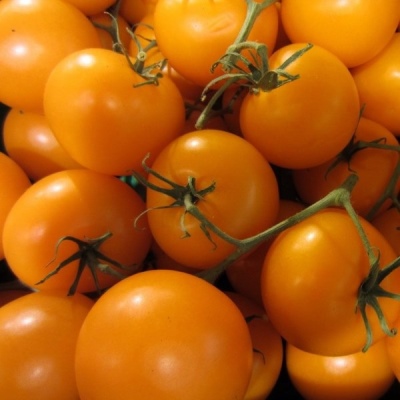
- Category: grade
- Appointment: fresh consumption, for pickling and preserving
- Ripening period: mid-early
- Ripening time, days: 90-100
- Growing conditions: for open ground
- Bush size: undersized
- Bush height, cm: 60-80
- Ripe fruit color: red-orange
- Fruit shape: flat-round
- Yield: up to 4-5 kg per bush
It is no coincidence that the tomato variety Marmeladny has gained such immense popularity among gardeners. The fruits are not only distinguished by their original appearance, reminiscent of oranges, but also have a unique taste, for which they even received the unofficial "Audience Award".
Description of the variety
A bright representative of mid-early low-growing varieties intended for growing in open beds. Bushes can grow to a height of 60 to 80 cm. The number of branches in a plant is not very large. Ovaries are formed often, each leaf is different. When their number reaches 6, the stem stops growing. Although the variety is considered by many to be standard, if a tomato bush is grown indoors, it can grow up to 1.5 m.
The main qualities of the fruit
The red-orange sunshine color of ripe Marmalade fruits looks very elegant. And medium-sized flat-round fruits attract attention, despite their modest weight of 150 g.
Taste characteristics
The taste of the Marmalade tomato variety has received many epithets. The fruit is fleshy, juicy, sweet, its dense pulp, in fact, is similar to marmalade both in its shade and sweetness. Of course, it is best to use this amazing fruit fresh, from the garden, but it is also good in salting and canned food.
Ripening and fruiting
You can wait to receive such ripe and tasty tomatoes in just 90-100 days. In this case, you need to start counting immediately after the emergence of seed shoots. This means that the variety can be classified as medium early. In July and August, you can enjoy the marmalade fruits.
Yield
Each bush ripens up to 4-5 kg of berries during the growing season. And this is a good indicator for an average vegetable.
The timing of planting seedlings and planting in the ground
The seeds of the Marmeladny variety are disinfected, they are sown on seedlings in March, while May is chosen for planting in the ground, but only after unexpected frosts have passed.

Growing tomato seedlings is an extremely important process, because it largely depends on whether the gardener will be able to harvest at all. All aspects must be taken into account, from seedbed preparation to planting in the ground.
Landing scheme
Small bushes of sweet tomato should be planted according to the scheme 30 by 50 cm. So they will feel good and at ease, and it will be easier for the gardener to take care of them.

Growing and care
The Marmalade tomato variety was created for cultivation using open-ground technology. Many people say that he is very unpretentious to care for.Although tomatoes can be grown outdoors, greenhouses are more favorable for him, as for most crops.
Plants are not tall, but they will also need to form a bush by cutting off or cutting off stepchildren. Tomato bushes, especially those with fruits, like tall species, are best tied to any solid support.
For sowing crops, you should definitely choose open areas, well-lit by the sun's rays, with excellent aeration, and the soil enriched with humus. It is also important to follow the watering schedules, do not forget to loosen and mulch the soil later, and also to feed. All these procedures are traditional and known to the majority. If gardeners perform simple crop care procedures, it is quite possible to get an early and good harvest for both an experienced grower and a beginner.




A plant needs different micronutrients at each stage of growth. All fertilizers can be divided into two groups: mineral and organic. Folk remedies are often used: iodine, yeast, bird droppings, eggshells.
It is important to observe the rate and period of feeding. This also applies to folk remedies and organic fertilizers.
Disease and pest resistance
Gummy tomato is incredibly resistant to major tomato diseases, especially late blight and powdery mildew. But preventive measures should still be carried out by spraying the plantings with folk and purchased means.


Resistant to adverse weather conditions
The culture withstands the cold well, while even in bad weather, both inflorescences and fruits are formed.

























































































